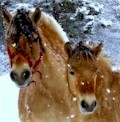Competing theories exist as to the time and place of initial domestication. The earliest evidence for the domestication of the horse comes from Central Asia and dates to approximately 4,500 BC. Archaeological finds such as the Sintashta chariot burials provide unequivocal evidence that the horse was definitely domesticated by 2,000 BC.
Riding Methods and EquipmentHorses are usually ridden with a saddle on their backs to assist the rider with balance, and a bridle on their heads to assist the rider in maintaining control. However, many riders ride on occasion without a saddle and some horses can be trained to perform without a bridle or other headgear. When a horse id prepared for a ride, it is first groomed to remove dirt, particularly from the areas where the saddle and bridle will be and has its hooves cleaned out to remove rocks or other debris that could lead to injury or lameness.
The common European practice and tradition of saddling and mounting the horse from the left hand side is widely believed to originate from the practice of right-handed fighters carrying their sheathed sword on their left hip, making it easier to throw their right leg over the horse when mounting. To correctly mount a saddled horse, the rider gathers the reins in their left hand, resting it on the horse’s withers, places his or her left foot into the left stirrup, grabs onto the saddle with his or her right hand (the pommel if in an equitation competition, more often the cantle in actual practice) and uses the stirrup as leverage to spring up from the ground, swing their right leg over the horse and sit into the saddle, placing their right foot into the right stirrup. Horses can be mounted bareback with a vault from the ground, by grabbing the mane to provide leverage as the rider makes a small jump and uses the momentum of the leg to swing up in a single, smooth motion, or by “bellying over,” a technique which involves placing both hand side by side on the horse’s back, jumping up so that the rider lays belly down on the horse's back, and swinging the leg over to sit astride.
Control of the HorseRiders communicate with the horse through commands called aids. The main natural aids of the rider are the legs, the seat, the hands through the reins, and the voice. The rider's legs generally tell the horse to move forward or to turn. The hands help to guide the horse in the direction of the turn, and ask the horse to either slow his tempo or to slow from a faster gait to a slower one. The seat is the most difficult aid to develop, and can communicate to the horse not only to speed up, but also to turn and slow down. The voice is used less when mounted than when on the ground, but may be used to reinforce the hands, seat, and legs to speed up or slow down the horse.
Correct position allows for the rider to communicate effectively without getting in the way of the horse. Though the position appears to be slightly modified according to the type of riding that is being performed, the fundamental need is to remain balanced over the horse at any given speed or discipline. Like most arts, riding takes years of practice to become competent as the riders work to refine their aids and position, and learn "feel" - the sense of what the horse is doing underneath them.
Types of RidingFrom the time the horse was domesticated, a wide variety of riding methods or style have developed all of which balance the need to allow the horse freedom of movement in activities such as horse racing or show jumping and the need for security and comfort for the rider, precision of commands, and overall control. Activities such as dressage and reining require high levels of control, while horse racing or show jumping require that a horse have considerable freedom of movement. Worldwide, the most common modern riding style is referred to in the United States as English riding, which is a broad style that encompasses most Olympic Equestrian competition and includes such specific style as dressage, hunt seat, show jumping, and saddle seat, among many others. Western riding is a popular style seen in North America, derived from the traditions of Spain, modified to fit the need of cattle ranchers.
